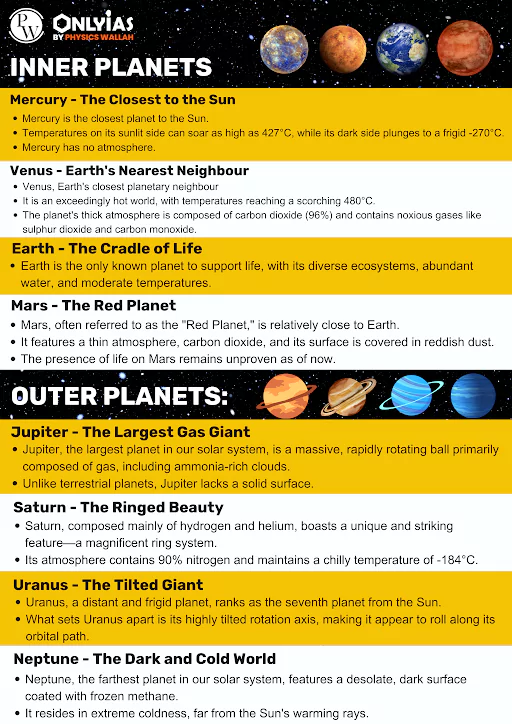Introduction to Solar System
The solar system is like a big cosmic family, with the Sun as its shining parent and planets, moons, and other space objects as its children. It’s where our home, Earth, lives along with seven other planets, each with its own unique traits.
Planets like Mercury, Venus, and Mars take turns spinning around it. Moons, comets, and asteroids join the lively dance, making our solar system a wondrous place to explore. Exploring this celestial neighborhood teaches us about the wonders of space and our place in the universe.
The Solar System: Exploring the Cosmic Ensemble of Our Solar System
- The Birth of Our Solar System : The nebula from which our Solar System originated began its collapse and core formation approximately 5-5.6 billion years ago, giving birth to the radiant Sun and its cosmic entourage.
- The Stellar Ensemble: Our solar system comprises a dazzling array of celestial objects, from the central star to a retinue of planets, moons, and smaller entities like asteroids and comets.
- Vast reservoirs of dust particles and gasses further enrich this stellar neighborhood.
A Comprehensive Guide to the Components of Our Solar System
The solar system is composed of various celestial objects and components.
- The Sun: The central and most massive component of the solar system, the Sun is a massive ball of hot, glowing gasses primarily composed of hydrogen and helium.
- It provides light, heat, and gravitational influence to all other objects in the solar system.
- Planets: The solar system comprises eight major planets that orbit the Sun.
- These planets, in order of their distance from the Sun, are Mercury, Venus, Earth, Mars, Jupiter, Saturn, Uranus, and Neptune.
- Dwarf Planets: In addition to the major planets, there are several dwarf planets in the solar system, including Pluto, Makemake, and Ceres.
- These objects share some characteristics with planets but do not meet all the criteria for full planetary status.
- Moons (Natural Satellites): Many celestial bodies in the solar system have natural satellites or moons.
- For example, Earth has one moon, while Jupiter has at least 79 known moons.
- Asteroids: Asteroids are rocky objects that primarily reside in the asteroid belt, a region between the orbits of Mars and Jupiter.
- The largest asteroid in the belt is Ceres.
- Comets: Comets are icy bodies that follow elliptical orbits, often originating from the outer regions of the solar system.
- When they approach the Sun, they develop a glowing coma and a tail due to sublimation of their ices.
- Meteoroids: Meteoroids are small rocky or metallic objects that travel through space.
- When a meteoroid enters Earth’s atmosphere and burns up, it creates a streak of light known as a meteor or “shooting star.”
- Kuiper Belt: Beyond the orbit of Neptune lies the Kuiper Belt, a region containing numerous small icy objects, including Pluto and other dwarf planets.
- It is also a source of short-period comets.
- Oort Cloud: The Oort Cloud is a hypothetical region even farther from the Sun, containing a vast number of cometary nuclei and icy objects.
- It is believed to be the source of long-period comets.
- Interplanetary Space: The vast space between celestial objects in the solar system, filled with dust, gas, and the solar wind, is known as interplanetary space.
- Solar Wind: The stream of charged particles, primarily electrons and protons, emitted by the Sun is called the solar wind.
- It extends throughout the solar system and affects the behaviour of objects within it.

- Unique Planetary Traits: Cosmic Oddities
- Venus and Uranus: Unconventional Rotation Venus and Uranus challenge the norm with their unconventional rotation patterns, spinning in opposite directions due to significant axial tilts.
- Pluto : The Dwarf Planet Once considered the ninth planet, Pluto has been reclassified as a dwarf planet, symbolizing our evolving understanding of celestial bodies in our cosmic neighborhood.
| Previous Year Question (Prelims)
Q. In order of their distance from the Sun, which of the following planets lie between Mars and Uranus? (2008) (a) Earth and Jupiter Ans: (b) |































